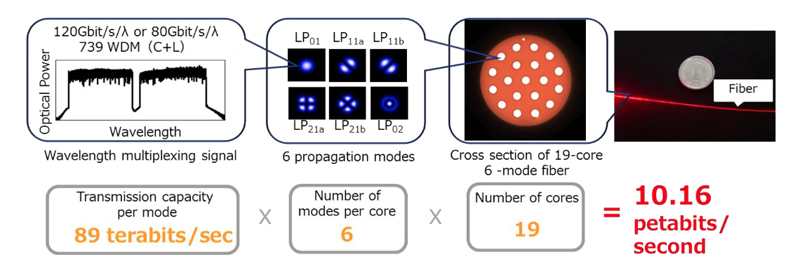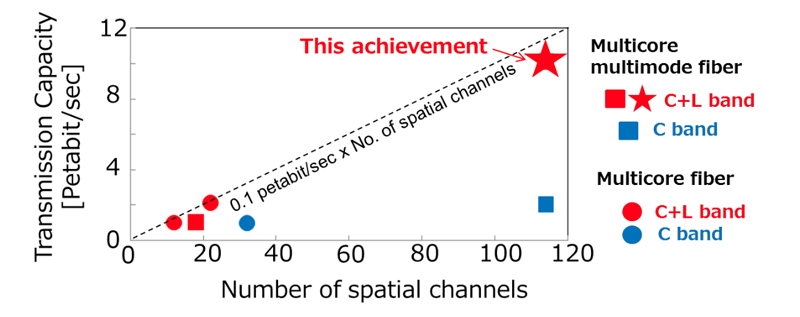17 Oct 2017
Company says record-breaking result will contribute towards technology to support post-5G mobile communications.
Japan's KDDI Research and Sumitomo Electric Industries have announced that their successful ultra-high capacity optical fiber transmission experiment has broken the world record for transmission capacity through a single optical fiber (2.15 petabits/second). The group achieved 10.16 petabits/s over multicore optical fiber, which enables 114-space multiplicity.
SEI commented, "The mobile communication system after 5G will require innovations both in wireless technologies and in the network and optical fiber transmission technologies that support them. Our new technology would be expected to be a key technology that will support broadband and a low latency mobile communications system after 5G and will provide new experiences and services."

Overview of multicore, multimode optical fibre transmission.
Future mobile communication systems will require a much greater capacity of optical fiber communication used in backhaul to provide a variety of services, such as IoT and connected devices, securely and safely. In conventional optical fiber (single core, single mode fiber) communication systems, transmission capacity was expanded with multiple wavelength using WDM technology.
However, the transmission capacity is considered to be limited to about 0.1 petabits/second because of the limitation on the launched input power or interference between signals. In recent years, the space division multiplexing (SDM) technology has been evolving worldwide that breaks through this limitation.
SDM technology includes a multicore fiber containing multiple cores in an optical fiber and multimode fiber using multiple transmission modes. One SEI report has shown that capacity was expanded up to 2.15 petabits/second using 22-core fiber that enables 22-spatial multiplicity.
Although the conventional multicore, multimode optical fibers with more than 100-spatial multiplicity had achieved a transmission capacity of 2 petabits/second, the maximum transmission capacity of 10 petabits/second, estimated from (0.1 petabits/second) x spatial multiplicity (100 or more), had not been achieved until the latest SEI experiment.
Achieving 10 petabit/s
In this experiment, SEI developed a performance-improved multicore, multimode optical fiber and KDDI Research provided signals to evaluate the 10-petabit transmission and then the transmission characteristics with an efficient approach to evaluate all the channels, achieving the record 10.16 petabits/second transmission over 11.3 km.
SEI added that this experiment demonstrates the feasibility of ultra-high capacity optical communication systems of more than 10 petabits/second using multicore, multimode optical fibers: "We will contribute to the development of the optical fiber transmission technologies for future versatile and large capacity data communication including 5G mobile system while assessing the range of applicability of multicore and multimode fibers," the company announced.

Star performer: Comparison between the latest experimental results (star) and other recent achievements.
Part of the FDDI-SEI optical fiber research is based on the results of the research and development for practical use of innovative fibers (i-FREE2) (FY 2013 to FY 2017) at Japan’s National Institute of Information and Communications Technology (NICT). This 10 petabit/s achievement was first reported as a post-deadline paper for ECOC 2017, the largest international conference in Europe on the optical communication technology, held in September 2017 in Gothenburg, Sweden.
| © 2025 SPIE Europe |
|